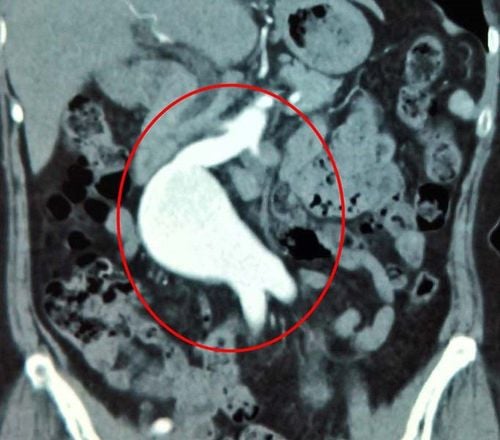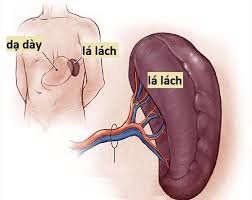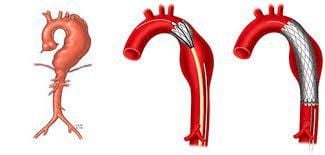This is an automatically translated article.
The article is expertly consulted by Master, Doctor Luu Thi Bich Ngoc - Doctor of Radiology - Department of Diagnostic Imaging and Nuclear Medicine - Vinmec Times City International General Hospital.Abdominal aortic aneurysm usually occurs in the elderly and in frequent smokers. This is a dangerous disease because the artery can burst at any time causing severe blood loss leading to death. To diagnose abdominal aortic aneurysm, doctors often order patients to perform an abdominal aortic ultrasound.
1. Common diseases of the abdominal aorta
The abdominal aorta is a segment of the largest major artery in the human body that supplies blood to the lower body.A common pathology in the abdominal aorta is aortic aneurysm. Its symptoms are often vague and unrecognizable, and may be asymptomatic until the artery ruptures, causing death.
Major causes of abdominal aortic aneurysm:
● Smoking is the leading cause of abdominal aortic aneurysm. According to research, smokers are 5 times more likely to get the disease than the average person.
● Due to the aging state of the body, most people with abdominal aortic aneurysm are over 60 years old
● High blood pressure patients are not treated in time
● Genetic factors are also a cause
● Abdominal trauma also causes progressive aneurysm or rupture of the abdominal aorta.

2. Significance of abdominal aortic ultrasound
To diagnose abdominal aortic pathologies, doctors usually order ultrasound. This is a noninvasive, inexpensive, repeatable method of diagnosing abdominal aortic aneurysms.The specificity of this method should be up to 95%, equivalent to CT and MRI methods.
However, if combined with abdominal aortic dissection is difficult to detect on ultrasound, if an abdominal aortic aneurysm is suspected, the patient will have a CT scan to further evaluate the lesion of aortic dissection if any
Abdominal aortic ultrasound has two main roles: diagnosis and monitoring of abdominal aortic aneurysms. The information doctors receive through ultrasound images include:
Diameter, length of aneurysm
● Diameter of aneurysm interior
● Relation of aneurysm to major arteries
With advantages However, in many cases, ultrasound also has certain limitations:
The patient is too fat, making it difficult for the ultrasound waves to penetrate deeply into the body
The abdomen is bloated and obstructed the ultrasound field.
In case of rupture of aneurysms.
3. Abdominal aortic ultrasound procedure

● Ultrasound probe preparation: Convex transducer for normal patients, and high frequency use for lean patients. Cardiac transducer for obese patients.
● The patient needs to fast before the ultrasound. It is best to have an ultrasound in the morning and without breakfast, this is the most suitable time for an ultrasound. Note to limit drinking carbonated water before the ultrasound.
● The patient lies on his back according to the doctor's instructions, avoiding tension in the abdomen leading to muscle tension. If it is difficult for the ultrasound to be performed, the doctor may ask you to lie on your side to perform the ultrasound.
● The doctor applies gel to the transducer and performs ultrasound of the abdominal aorta in cross-section and longitudinal section from below the diaphragm to the iliac junction.
● Measure the anterior and posterior diameters of the abdominal aorta, study the flow, assess the origin of the visceral trunk arteries, renal arteries, superior and inferior mesenteric arteries, and main iliac arteries.
Abdominal aortic aneurysm is a dangerous sign that threatens to rupture the abdominal aorta. If detected late, the rupture will lead to massive bleeding out of the vessel wall that blood transfusion cannot respond. In addition, the large amount of blood overflowing into the abdomen also obstructs the vision during surgery, thereby affecting the time to find broken blood vessels, surgical stitches, and prolonging the surgery time.
Master, Doctor Luu Thi Bich Ngoc has 06 years of experience working in the field of diagnostic imaging, received formal training and graduated with a Master's degree from Hanoi Medical University. Dr. Ngoc has strengths in diagnosing breast, thyroid, liver cancers early. experience in doing ultrasound of tissue elastography for liver, breast, thyroid diseases... From 2019 until now, Dr. Ngoc has worked at Vinmec Times City International Hospital with a position at the department. Image analysation.
Please dial HOTLINE for more information or register for an appointment HERE. Download MyVinmec app to make appointments faster and to manage your bookings easily.














